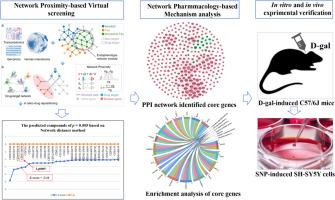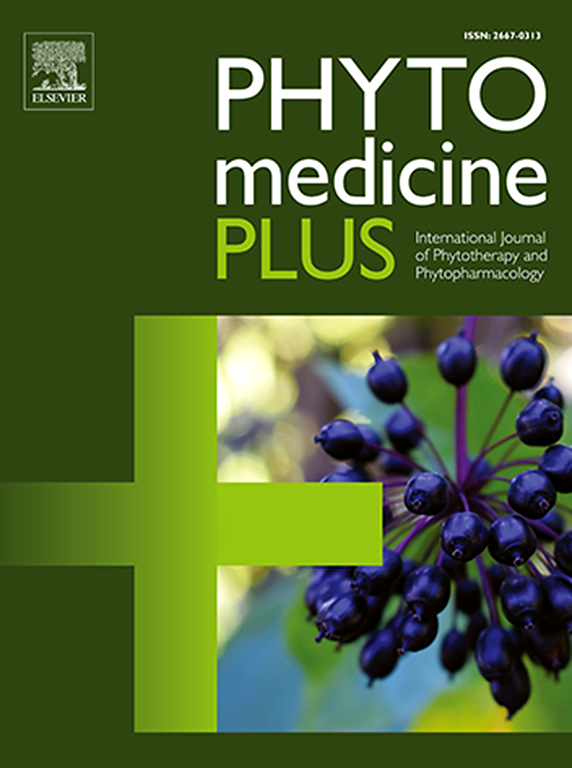异hapontigenin是一种针对多种途径的潜在抗ad天然产物,通过网络接近和基因富集分析发现
Q3 Pharmacology, Toxicology and Pharmaceutics
引用次数: 0
摘要
背景:阿尔茨海默病(AD)是一种慢性进行性脑神经退行性疾病,其病因不明,发病机制复杂。仍然迫切需要有效的治疗方法。天然产物(NPs)在预防/治疗神经退行性疾病方面显示出巨大的潜力。方法利用网络邻近法(NPM)鉴定出具有潜在抗ad活性的NP Lg0005 (p = 0.05, z = -3.11)。基因本体(GO)和京都基因基因组百科全书(KEGG)富集分析阐明了其抗ad的作用机制(MOA)。采用d -半乳糖(D-gal)诱导的AD大鼠模型和SH-SY5Y细胞验证神经保护作用。结果kegg分析显示Lg0005主要通过AD、氧化磷酸化、凋亡、TNF等信号通路起作用。氧化石墨烯分析表明,它针对线粒体电子传递、线粒体成分和氧化还原酶活性等。分子对接和体外/体内实验证实Lg0005抑制小胶质细胞/星形胶质细胞活化,减少TNF-α和IL-1β释放。此外,它通过降低MDA和增加过氧化氢酶来减轻氧化损伤,改善线粒体超微结构损伤,增加海马DG区尼氏体计数和突触密度,其疗效与β-烟酰胺单核苷酸(NMN)和多奈哌齐相当。综上所述,Lg0005通过降低氧化应激、抑制神经炎症、保护线粒体和神经元完整性,显著改善AD模型的认知功能。结论结合NPM、网络药理学和实验验证,本研究发现Lg0005是一种新的抗ad候选药物,为神经退行性疾病的治疗提供了新的策略。本文章由计算机程序翻译,如有差异,请以英文原文为准。

Isorhapontigenin, a potential anti-AD natural product targeting multiple pathways, discovered via network proximity and gene enrichment analyses
Background
Alzheimer's disease (AD) is a chronic, progressive neurodegenerative disorder of the brain characterized by an uncertain etiology and complex pathogenesis. Effective therapeutics remain urgently needed. Natural products (NPs) show significant potential in preventing/treating neurodegenerative diseases.
Methods
In this study, the network proximity method (NPM) identified the NP Lg0005 (p = 0.05, z = -3.11) with potential anti-AD activity. Gene Ontology (GO) and Kyoto Encyclopedia of Genes and Genomes (KEGG) enrichment analyses elucidated its anti-AD mechanism of action (MOA). Neuroprotective effects were validated using D-galactose (D-gal)-induced AD rat models and SH-SY5Y cells.
Results
KEGG analysis revealed Lg0005 primarily acts via AD, oxidative phosphorylation, apoptosis, and TNF signaling pathways, etc. GO analysis indicated it targets mitochondrial electron transport, mitochondrial components, and oxidoreductase activities, etc. Molecular docking and in vitro/in vivo experiments confirmed Lg0005 inhibited microglia/astrocyte activation, reducing TNF-α and IL-1β release. In addition, it alleviated oxidative damage by decreasing MDA and increasing catalase, ameliorated mitochondrial ultrastructural damage, and increased both Nissl body count and synaptic density in the hippocampal DG region, with efficacy comparable to β-nicotinamide mononucleotide (NMN) and donepezil. In summary, Lg0005 significantly improved cognitive function in AD models by reducing oxidative stress, suppressing neuroinflammation, and protecting mitochondrial and neuronal integrity.
Conclusions
Integrating NPM, network pharmacology, and experimental validation, this study identified Lg0005 as a novel anti-AD candidate, offering a new strategy for neurodegenerative disease therapeutics.
求助全文
通过发布文献求助,成功后即可免费获取论文全文。
去求助
来源期刊

Phytomedicine Plus
Medicine-Complementary and Alternative Medicine
CiteScore
3.70
自引率
0.00%
发文量
178
审稿时长
81 days
期刊介绍:
 求助内容:
求助内容: 应助结果提醒方式:
应助结果提醒方式:


